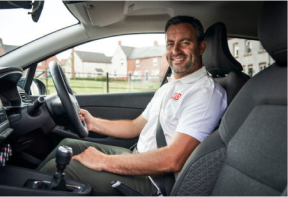REDdy to make sharing roads safer
98% of cyclists feel more should be done to educate new drivers on the importance of cyclist safety

According to research from the UK’s largest driving school, 98 per cent of cyclists want their safety to form a greater part of the learning to drive period.
The survey of over 1,000 cyclists by RED Driving School, asked what would have the greatest impact on the safety of road cyclists:
- Most respondents felt further education for new drivers on how to share the roads with cyclists was more important than a new approach to cycling lanes, greater penalties for drivers or more training for cyclists;
- Over half of the cyclists surveyed said they had been involved in a road traffic collision while cycling as a result of dangerous driving; and
- 83 per cent said they believe it is the responsibility of the driver to act with caution when cyclists are on the road.
To help both learner drivers and cyclists share the roads safely, RED Driving School has launched a campaign called Get Road REDdy, aimed at raising awareness of the importance of road safety and calling for all types of road users to ‘road train their brain’.
The campaign includes a series of e-learning modules known as RED’s Road Brain Trainer aimed at the learner driver. Now, RED has also unveiled a new module called RED on Two Wheels, specifically for youngcyclists. The tool is designed to better equip cyclists to use the roads.
Commenting, Ian McIntosh, Chief Executive of RED Driving School, said: “It’s alarming that over half of the respondents said they feel vulnerable or extremely vulnerable when cycling on UK roads. When asked why this was, 47 per cent said that new drivers pose a high risk to cyclists.”
According to the 2012 National Travel Survey, approximately 2 per cent of all trips in the UK are made by bicycle. Despite this relatively small percentage, around 19,000 cyclists are killed or injured on UK roads each year, according to the Royal Society for the Prevention of Accidents.

Mr McIntosh continued: “Clearly something needs to be done to help protect cyclists and part of this can be addressed while teaching learner drivers how to share the roads safely. This is why RED has launched its Road Brain Trainer; a series of e-learning modules to help develop learners’ cognitive skills to become better, safer drivers.”
“At RED, we want to address the issue of cycling safety from both angles; through the e-learning modules for learner drivers and now cyclists, we’re helping both parties to become better, safer road users.”
Speaking about the work RED is doing to help improve road safety, Matt Lamy, chief writer at Cycling Active magazine, said: “By teaching that the roads are there to be shared, I hope what RED is doing with its learner drivers will make life safer and more enjoyable for both cyclists and drivers.”
Rodger Geffin, campaigns and policy director at CTC – the national cycling charity, further added: “Cyclists and drivers are often the same people – most cyclists also drive. However, drivers who don’t cycle are known to have a lesser understanding of cycle safety than those who do, causing unnecessary tension and danger on our roads.”
“Raising driver awareness of cyclists’ safety – or indeed encouraging more people to do some actual cycle training – are great ways to help create more civilised and less congested streets. Initiatives like this can encourage more people to cycle safely and confidently, or allow their children to do likewise”
“Good cycle training might also help you pass your driving test more quickly, as well as making you a safer driver.” 97 per cent of cyclists surveyed in the research said that as well as changes to the learning to drive process, changes also need to be made to the way learner drivers are assessed. This should include the addition of a compulsory cyclist element as part of the theory and hazard perception test.
Mr McIntosh added: “Interestingly, the results of our research suggest that cyclist safety has a lot to do with hazard perception and the way a driver mentally approaches a situation; almost 79 per cent of the respondents said that as a cyclist, they felt they were more vigilant when driving alongside cyclists.”




